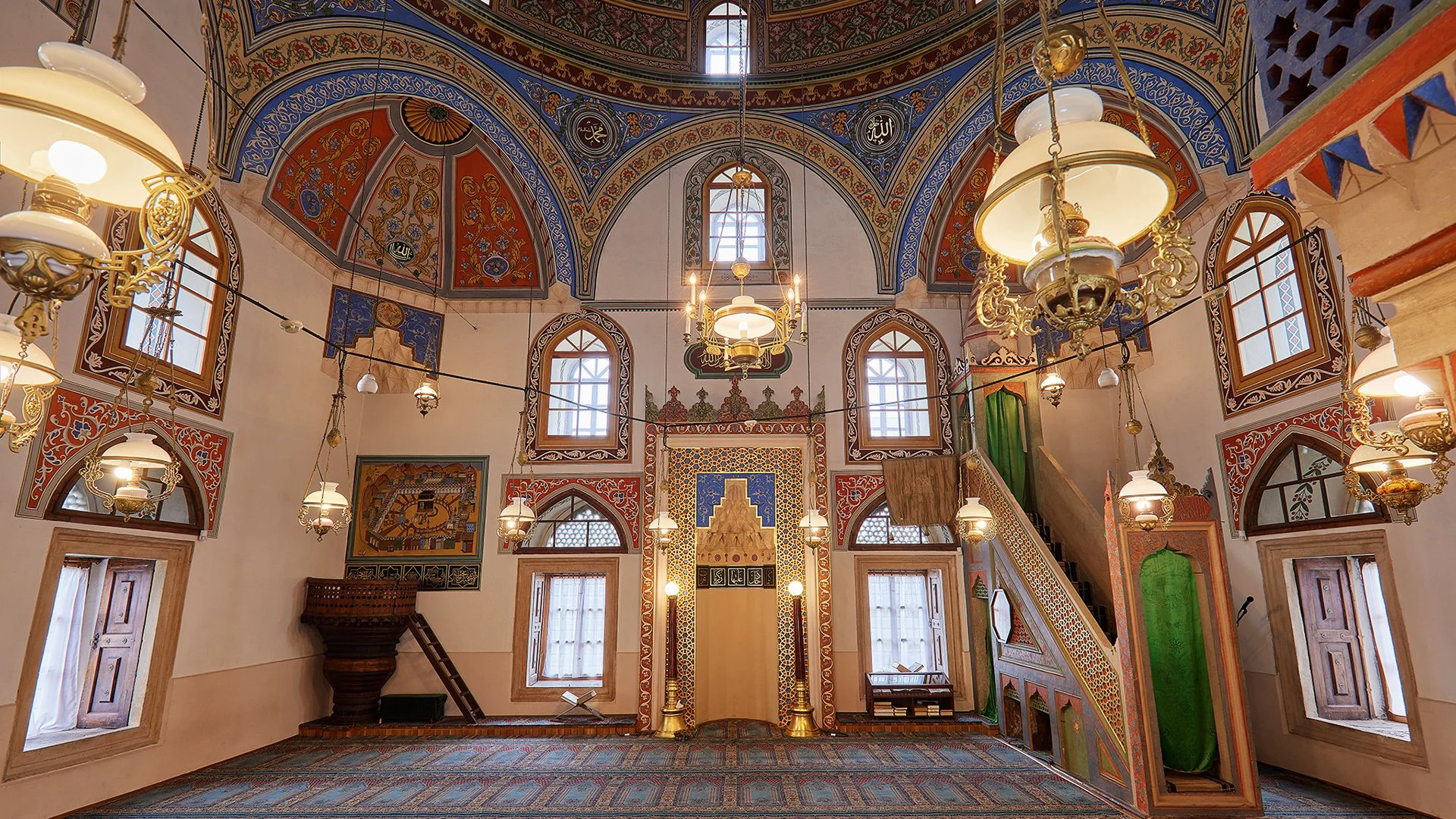
HUSEIN-PASHA BOLJANIĆ MOSQUE IN PLJEVLJA
ARCHITECTURAL JEWEL OF SANDŽAK
Author: Prof. Aida Abadžić-Hodžić, PhD, Faculty of Philosophy of University of Sarajevo • Photo & video: Mirza Hasanefendić
In his descriptions of the “beautiful town of Taslidža”, Turkish travel writer Evlija Čelebi, who stayed in this town in 1664, recorded the extreme beauty of architecture and interior design of Husein-pasha Boljanić Mosque which, according to him, could arouse envy even of the best Persian miniature painters:
Husein-pasha Boljanić Mosque is the most impressive and the most beautiful. It looks like an imperial mosque. (...) It has a beautiful, artistically made minaret and a blue and high dome. It is a round, high dome and (it looks like) it has just been taken out of a turner's wheel. There are six more semi-domes around this dome and, outside the southeast gate there are again three domes, each with four marble pillars. In all the four corners of the mosque there are also four decorative domes. (...) This mosque has a minbar (pulpit), which has also been artistically made. A master sculpted the marble in such a way that he can only be congratulated for his skill. Above the minbar, there is a picture of Kaaba on black velvet, embroidered and decorated with gold, which could arouse envy both in Mani and in Behzad.
Husein-pasha Boljanić Mosque in Pljevlje is one of the most beautiful and the most representative single-space domed mosques in the Balkans, and the beauty of its proportions and its interior decoration is associated to Aladža Mosque in Foča, Ferhadija in Banja Luka, Karađoz-beg Mosque in Mostar and Ali-pasha Mosque in Sarajevo.
Husein-pasha Boljanić founded a rich and significant waqf in Pljevlje and, within it, commissioned this mosque which, by its building characteristics and the way of decoration confirms Husein-pasha's influence and power, as well as the significance of Taslidža as an urban, economic and administrative center of the time. It was during the administrative rise of Husein-pasha that Taslidža progressed from a former medieval square and obtained a status of a town (1570), and from 1576 it also became the center of Herzegovinian sanjak-bey.
Husein-pasha was one of the most significant personalities for the development of Pljevlje. He was born in the village of Boljanići, about twenty kilometers away from Pljevlje and he held high-ranked and responsible positions with the Ottoman government. Besides his own abilities, it was indubitably a result of the support and help of the grand vizier Mehmed-pasha Sokolović, as Husein's older brother Sinan was married to his sister Šemsa. The period of Selim II Sultanate, when Mehmed-pasha Sokolović was the vizier, was the period of Ottoman building renaissance and the peak of creations by mimar Sinan whose influence, as the main architect of the empire over four decades, was evident on the representative buildings in the Balkans, when the most dynamic building activity was recorded.
Although the name of the designer of Husein-pasha Mosque is not known and there is no written trace, it is assumed, due to an extreme value of the design, that the drawing was made by mimar Hajrudin, the designer of the Old Bridge in Mostar, who had previously also worked on the fortress in Makarska. It is highly likely that Dubrovnik masters cooperated with him, since Husein-pasha maintained extremely good ties with the Dubrovnik Republic. This assumption was made by Andrej Andrejević, who also underscored the element of the high drum of the dome, reinforced by pilasters on the outside, which can be seen on representative mosques in this region. It is also a fact that the Boljanić brothers were Bosnian and Herzegovinian regents several times in the period between the 1560s and the 1590s, and were therefore able to engage mimar Hajrudin for the design of the central building of their endowment. It is assumed that Husein-pasha commissioned the mosque in Pljevlje, the dating of which is a subject of some disputes, at the same time when his brother Sinan-bey commissioned one in Čajniče (1570). The extremely rich decoration (stalactite-like ornaments of the doorway, mihrab and capitals) and luxuriously painted surfaces of all elements of the interior, as well as a distinctive, unique element of decorative domes of turrets on the corners of the cube of the central dome associate, according to Andrejević, Husein-pasha Mosque in Pljevlje to representative solutions of Sinan's architecture in the imperial capital.
Husein-pasha Mosque has also preserved a very valuable transcript of the Qur'an from 1571. Due to the beauty of writing and ornaments, the transcript by an unknown calligrapher is included among the most valuable samples of Islamic calligraphy in the South Slavic regions. The luxuriant interior decoration of the mosque, with complex intertwining of geometric and stylized floral motifs, indicate patterns of monumental mosques of Sinan's time and includes this mosque among jewels of the architecture of Sandžak.
References:
Andrejević, Andrej (1984), Islamska monumentalna umetnost XVI veka u Jugoslaviji: kupolne džamije, Beograd.
Andrejević, Andrej (1978), Pljevaljska džamija i njeno mesto u islamskoj umetnosti na našem tlu, Prijepolje.



































































